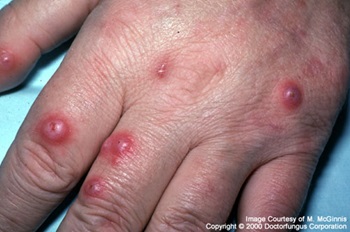Cryptococcosis is a chronic systemic fungal disease, respiratory in origin, which disseminates characteristically to the central nervous system and occasionally to the genitourinary tract, skin, bone, and other organs.
Etiology of Cryptococcosis .
Cryptococcosis is due to a thin-walled, spherical to oval fungus, Cryptococcus neoformans, measuring 4 to 20 ju. in diameter. It is surrounded by a polysaccharide capsule, the size of which varies from strain to strain but which may equal in thickness the diameter of the cell. Reproduction is by budding, and the buds are attached to the parent cell by a thin wall and narrow pore. On Sabouraud’s glucose medium, soft, mucoid, cream-colored colonies are formed. Recently a hyphal form of the fungus has been found on culture media, in human tissue, and in human specimens. The morphology and taxonomy of the fungus are currently undergoing re-evaluation. Mice and other laboratory animals can be infected. C. neoformans is a poor antigen, and no skin test or complement-fixing antigen is commercially available.
Epidemiology of Cryptococcosis .
The disease is worldwide in distribution, affects all ages (40 to 60 years more commonly), and males almost twice as frequently as females. The fungus has been shown by Emmons to be a saprophyte in excreta of pigeons, although the birds need not be infected systemically. Epidemics of mastitis in dairy cattle and spontaneous cryptococcosis in the cow, horse, dog, cat, leopard, and other animals have been reported. Animal-to-man or man-to-man contagion is unknown.
Pathology of Cryptococcosis .
The distinctive feature of cryptococcosis is the paucity of cellular reaction and the absence of suppuration, necrosis, caseation, infected abscesses, or hemorrhage. In early lesions the tissue granulomas are gelatinous (mucinous), and in older lesions these may be granulomas with tissue macrophages, giant cells, lymphocytes, and plasma cells.
Lung lesions may be single or multiple, but the most common is a subpleural nodule. In cases of meningitis there is thickening of the meninges, especially at the base, with exudation and occasionally hydrocephalus. Neural parenchyma, especially of the optic nerves, may be involved, and there may be compression of tissue by expanding masses of fungal cells.
Clinical Manifestations And Pulmonary Form.
Cryptococcosis limited to the lungs is being recognized more frequently, and is only currently being characterized. Cough, sputum production, low-grade fever, malaise, and weight loss may be present. Pleural effusion rarely occurs. Physical findings when produced by infection are due to consolidation. The chest film shows, usually, a solitary nodule in the lower lung fields, less frequently localized, or bronchopneumonic infiltration and pleural effusion. Miliary lesions are rare except in patients with lymphomas. In many cases symptoms and physical and roentgenographic findings are those of the underlying disease, e.g., bronchitis, inactive tuberculosis, or bronchiectasis, to which the Cryptococcus is only an asymptomatic superinfection or a transitory, mild complicating pneumonia.
Central Nervous System Involvement.
In cryptococcal meningitis the onset may be acute and the course fulminant, but more commonly begins insidiously. In about 10 per cent of patients infection is present without symptoms or findings suggestive of meningeal or nervous system disease. Intermittent and increasing headache, impairment of vision, and vertigo commonly occur. In nearly one fourth of the cases the clinical picture has been so suggestive of an expanding intracranial lesion that surgical procedures have been done. Characteristic cerebrospinal fluid findings are pleocytosis with lymphocytes predominating, low glucose, and high protein.
Other Disseminated Forms.
Skin lesions in the form of ulcers, papules, pustules, mucosal ulcers, or nodules are seen in 10 per cent of cases.Bone lesions occur in 10 per cent of cases (and in the first case described by Busse-Buschke). Pain, swelling, and a slowly progressive course are suggestive of osteomyelitis. Periostitis, occasionally seen in actinomycosis, coccidioidomycosis, and blastomycosis, is rare in cryptococcosis. Septic arthritis occasionally occurs.Lesions in the kidney, with perirenal abscess, in the prostate, adrenals, and endocardium are sometimes encountered. Recently typical acute pyelonephritis caused by C. neoformans has been described.
Diagnosis of Cryptococcosis.
The diagnosis is established by the isolation of C. neoformans in culture from cerebrospinal fluid, sputum, blood, pleural effusion, ascites, skin, or bone biopsy material. Occasionally, and even in cases of frank meningitis, fungus is cultured from cerebrospinal fluid only after many attempts. In these patients the fungus may be cultured from other specimens, especially urine. In partially treated cases the fungus cannot be cultured from cerebrospinal fluid, but may be clearly identified with India ink preparation.
Cryptococcosis should be suspected especially in patients with leukemia, Hodgkin’s disease, sarcoidosis; or diabetes mellitus who develop fever or central nervous system manifestations.Cryptococcal pulmonary disease must be distinguished from tuberculosis, other fungal infections and (less frequently) from bacterial pneumonia. Except for a more prolonged course, cryptococcal meningitis resembles that resulting from tuberculosis. Cryptococcal adrenal insufficiency, endocarditis, skin lesions, and pyelonephritis must be distinguished from identical disease caused by bacteria.
Treatment of Cryptococcosis.
Amphotericin B has been highly successful therapy in cryptococcal infections, The methods of intravenous treatment are described in the article on Histoplasmosis. Intrathecal therapy, described under Coccidioidomycosis, has been recommended for those patients with severe, life-threatening disease or for those whose disease has relapsed following intravenous therapy. 5-Fluorocytosine has appeared active in some patients, but it is too early to state its exact role, daily dose, duration of therapy, or toxicity.
